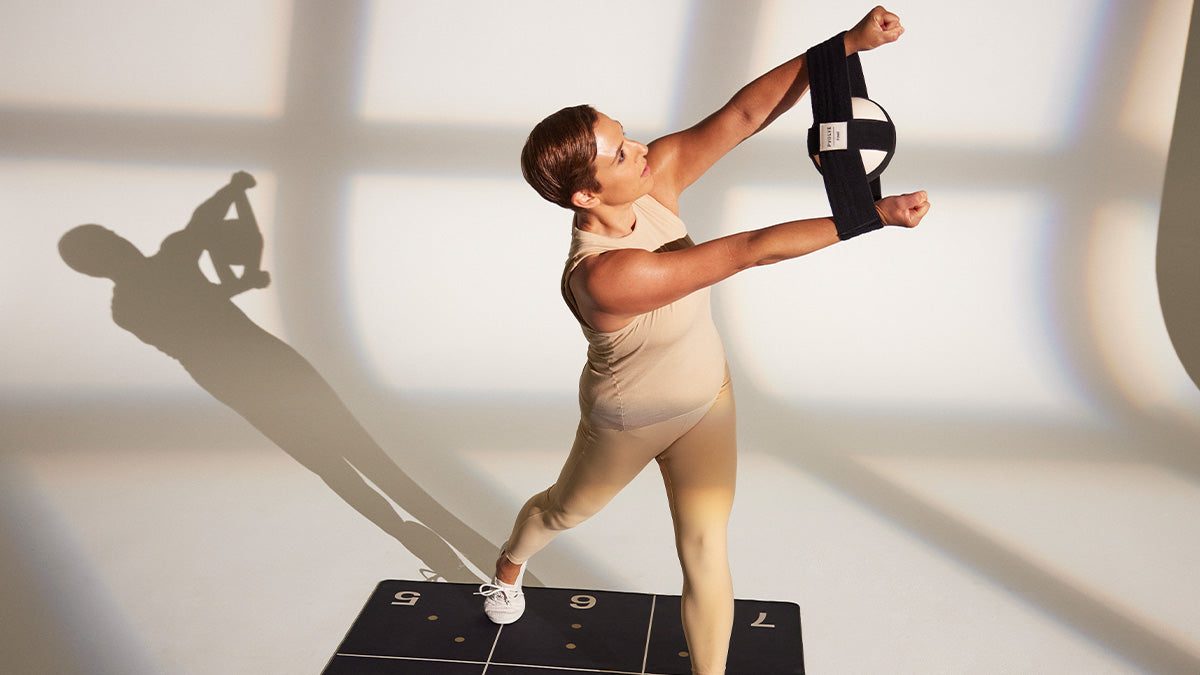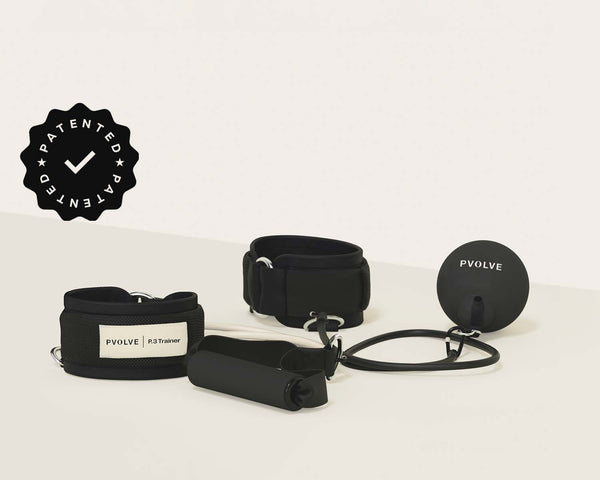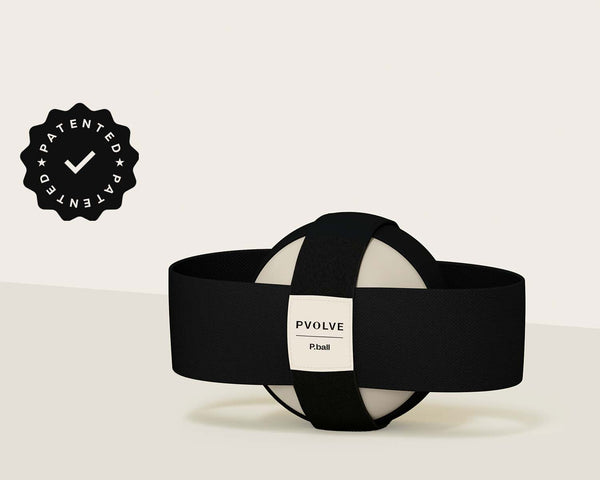At Pvolve, we set out to help every woman feel powerful in her mind and body throughout her lifetime. And it all starts with addressing the gap in women’s health research. In our Healthy Aging clinical study, we compared Pvolve against standard fitness routines in women 40+, and showed our method improves range of motion, increases muscle mass, and boosts daily energy.
We’re asking Professor Francis Stephens, professor of Exercise Physiology and Metabolism whose team conducted the study at University of Exeter, to break down the findings for us. Significant improvements in strength and mobility were seen in participants who followed the Pvolve method, compared to where they were at the beginning of the clinical study. On the other hand, no significant improvements were seen for participants who followed standard activity guidelines of 150 minutes per week of moderate cardio and strength training.
Significant improvements in strength and mobility were seen in participants who followed the Pvolve method, compared to where they were at the beginning of the clinical study. On the other hand, no significant improvements were seen for participants who followed standard activity guidelines of 150 minutes per week of moderate cardio and strength training.
*Results pending peer review from 12-wk clinical trial, 72 women 40-60 y.o., 4 Pvolve workouts/wk vs. 150 min/wk standard activity.
1. What makes the University of Exeter a global leader in exercise and sports science?
University of Exeter is one of the foremost global sports science teams that’s continually recognized for its world-leading research impact. We are one of the leading Sport and Exercise Sciences research departments in the UK. In the most recent Research Excellence Framework (REF 2021), the UK government’s main measure of university research quality, we ranked 1st in the UK.1 100% of our research has international impact and 99% is internationally excellent.2
1Based on research impact rated 4* in REF 2021. Submitted to UoAA2 Sport and Exercise Sciences, Leisure and Tourism.
2Based on research rated 4* and 3* in REF 2021
2. Could you tell us more about your team and what keeps you at the forefront?
I lead the Nutritional Physiology Group, a dynamic team of four academic members of staff and several postgraduate and postdoctoral researchers. Our research is focused on human skeletal muscle metabolism in response to exercise and nutrition, how this adapts with exercise training, physical inactivity and aging, and how we can affect adaptation and performance with novel nutritional or exercise interventions. The study was primarily conducted by two PhD candidates, Erika Svensen and Chris Koscien, under the supervision of myself and Professor Benjamin Wall.
We stay at the forefront of our research field as we measure muscle metabolism and adaptation to exercise training as directly and precisely as possible with a combination of state-of-the-art techniques that are not routinely found in other UK universities.
3. What makes the Healthy Aging study exciting for you and your group?
It is vitally important that people stay healthy for as long as possible throughout their lifetime, particularly women who may spend up to half of their life postmenopause. We know that resistance exercise and strength training have a multitude of beneficial effects on bodily systems including musculoskeletal, cardiovascular, neuromuscular, and cognitive. Even people who are active and have good mobility can benefit from strength training. However, we also know that adherence and compliance to resistance exercise training is not great, so there is a need to develop accessible, home-based resistance exercise training interventions.
The Healthy Aging study is exciting for our group as we have seen the health benefits of a novel low impact resistance exercise training program in real-time, and have seen how enjoyable it has been for the women taking part in the study. We’re also very excited to understand more about the biological mechanisms by which training has improved muscle strength and function in pre-, peri-, and post-menopausal women.
4. Tell us what the Healthy Aging study set out to do and the study methodology.
Menopause accelerates muscle loss and weakness and ultimately increases the risk of falls and fractures, particularly of the hip. Improving hip muscle strength is associated with improved bone mineral density and performance in physical function and balance tests. The primary aim of the study was to determine if performing Pvolve's low impact, resistance-based program several days a week for 12-weeks could increase strength and stability of the lower limbs in 72 women of menopausal age (40-60 years), compared to regular exercise advice. Forty-five of the participants came to our laboratory to follow Pvolve’s streamed workouts under supervised conditions, while the other 27 participants continued to follow recommended healthy exercise guidelines. A strength of the study was that 98% of all of the supervised sessions were attended by the participants, which is an excellent adherence for this type of research.
5. What were the main study findings you discovered?
The main study findings were improved lower limb muscle strength and function by around 20% compared to control. Interestingly, the amount of strength loss observed in women from the age of 25 to 55 is also thought to be around 20%. The increase in strength was associated with around a 10% improvement in lower body balance and mobility, and a 20% improvement in flexibility, both of which would be expected to reduce the risk of falls in later life. There were also increases in lean muscle mass without weight gain, as well as improvements in qualitative measures like improved energy and quality of life.
6. Why was it important to test Pvolve’s method against standard physical activity guidelines?
To test the effectiveness of any exercise program, a secondary group is required in order to compare the results over a period of time. We chose to compare Pvolve to standard physical activity guidelines, as these are considered by UK and US governments and leading health authorities to be beneficial for health.
7. How did you measure the changes observed in the participants’ bodies? (how do you measure lean muscle, for example?)
Measurements were made using gold standard, validated techniques. Muscle strength and function were measured by asking participants to perform maximal muscle contractions on an isokinetic dynamometer, a device routinely used for muscle testing and rehabilitation by medical and physiotherapy professionals. Balance and mobility were measured using a Y-balance system, a reliable and sensitive measure often used to assess injury risk, where participants balance on one leg and see how far they can move their other leg in various directions. Flexibility was measured with a ‘sit and reach test’. Lean tissue mass and muscle thickness were measured using dual-energy x-ray absorptiometry (DXA) and ultrasound scans, respectively. Measures for quality of life and enjoyment of exercise were assessed by validated questionnaires such as the SF36, a set of easily administered, quality-of-life measures.
8. Women have been underrepresented in clinical research. Why do you think this demographic has been overlooked, and how do studies like Healthy Aging advance women’s health research?
Women have certainly been historically underrepresented in sports medicine and muscle and exercise physiology research. Women have constantly changing and complex hormonal profiles throughout their teenage and adult lives, which affect numerous biological systems within the body. One thought is that scientists have avoided using women as research participants due to difficulties in controlling for changes in such hormones (e.g. changes in estrogen across the menstrual cycle), as well as difficulties in interpreting results of experiments that may have been affected by changes in such hormones. Therefore, all too often research findings from exercise studies involving men have been applied to women. However, the research climate is certainly different now and scientists are routinely researching the effects of female sex hormones on exercise performance, muscle metabolism, and adaptation to training across the life course. Indeed, Pvolve has funded research with our group investigating how changes in hormones across the menstrual cycle can affect how muscle responds and adapts to exercise training and nutrition in young women.
9. Could you speak to the efficacy of Pvolve’s equipment used in the study?
While the study wasn’t aimed to test the efficacy of Pvolve’s equipment, the increases in muscle strength and function in response to the Pvolve program is similar to the increase shown in studies using more gym-based heavy resistance programs. This would suggest that when applied in a focused and supervised setting, Pvolve equipment can be just as effective as weight-lifting equipment you might find in a commercial gym.
10. Why should anyone care about their strength and lean muscle as they age?
Aging, and in particular menopause, accelerates muscle loss, weakness, immobility, and ultimately increases the risk of falls and fractures. These declines invariably lead to an inability to perform tasks of everyday living, resulting in a loss of independence and quality of life. Anyone wishing to increase their lifespan should also be aiming to increase their ‘healthspan’ i.e. living healthier for longer.
11. What’s the take home message for someone interested in Pvolve’s method? What can they understand from the study results?
The Pvolve program is a simple, online-streaming, low impact resistance program that can be used as an option to effectively increase muscle strength, function and balance, which may lead to improved overall health and wellbeing.
12. Why should academic universities partner with companies on research like this?
Companies such as Pvolve develop exercise programs and equipment through years of experience and innovation. Academic universities are ideally placed to help test the efficacy of such programs and equipment. As well as being able to conduct high-quality, randomized controlled clinical trials, academic institutions have state-of-the-art technology which can help in the development of future programs and equipment to make them as beneficial as possible. In addition, by funding postgraduate PhD students to conduct such research, companies contribute directly to training the next generation of researchers and innovators in the field.
Further reading
To explore the classes check out the University of Exeter x Pvolve Healthy Aging Calendar
To learn more about this milestone research and how women can improve fitness and health during their midlife years, please visit: https://www.pvolve.com/pages/method






































